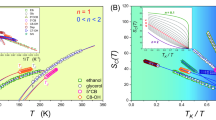Abstract
The transient hot-wire method is used for simultaneous measurements of the thermal conductivity λ and the heat capacity per unit volumepc p and yields a peak in λ and a dip inpc p near a glass transition. Through simulations, it is shown that these anomalous results arise due to a time dependence inc p , which is described by a fractional exponential function:c p (t)=c p (liquid)+[c p (glass)-c p (liquid)c -(t,τ)β], where τ is the heat capacity relaxation time and β is a sample dependent parameter (0<β≤1). By a comparison with experimental data for cyclohexanol and glycerol, it is demonstrated that this model can be used to reproduce the peak and the dip as well as the temperature at which these occur. In addition, it is shown that the maximum in λ occurs at τ-0.3 s, whereas τ of the minimum inpc p is dependent on β and moves from 0.4 to 1 s for a change in β from 1 to 0.5. The difference in τ between the peak and the dip is in agreement with the experimental results. It is concluded that the anomalies reveal glass forming characteristics such as a rough classification in terms of strong and fragile glass formers.
Similar content being viewed by others
References
W. Götze and L. Sjögren,Rep. Prog. Phys. 55:241 (1992).
E. Donth,J. Non-Cryst. Solids 53:325 (1982).
A. Hensel, J. Dobbertin, J. E. K. Schawe, A. Boller, and C. Schick,J. Thermal. Anal. 46:935 (1996).
N. O. Birge,Phys. Rev. B 34:1631 (1986).
Y. H. Jeong and I. K. Moon,Phys. Rev. B 52:6381 (1995).
J. J. Healy, J. J. de Groot, and J. Kestin,Physica 82C:392 (1976).
P. Andersson and G. Bäckström,Rev. Sci. Instrum. 47:205 (1976).
B. Hakansson, P. Andersson and G. Bäckström,Rev. Sci. Instrum 59:2269 (1988).
H. S. Carslaw and J. C. Jaeger,Conduction of Heat in Solids, 2nd ed. (Clarendon Press, Oxford, 1959), pp. 341–344.
O. Sandberg, P. Andersson, and G. Bäckström, inProc. 7th Symp. Thermophys. Prop., A. Cezairliyan, ed. (ASME, New York, 1977), pp. 181–184.
O. Sandberg and G. Bäckström,J. Polym. Sci. 18:2123 (1980).
O. Sandberg and B. Sundqvist,J. Appl. Phys. 53:8751 (1982).
O. Andersson, R. G. Ross, and G. Bäckström,Mol. Phys. 66:619 (1989).
G. Bäckström,Fields of Physics on the PC by Finite Element Analysis (Studentlitteratur, Lund, 1994).
O. Andersson, Ph.D. thesis (Umea University, Umea, 1991).
O. Andersson, A. Soldatov, and B. Sundqvist,Phys. Lett. A 206:260 (1995).
K. Adachi, H. Suga, S. Seki, S. Kubota, S. Yamaguchi, O. Yano, and Y. Wada,Mol. Cryst. Liq. Cryst. 18:345 (1972).
D. L. Leslie-Pelecky and N. O. Birge,Phys. Rev. Lett. 72:1232 (1994).
C. A. Angell,J. Non-Cryst. Solids 131–133:13 (1991).
S. R. Elliott,Physics of Amorphous Materials, 2nd ed (Longman Group UK Ltd., Hong Kong, 1990).
B. Wunderlich,J. Phys. Chem. 64:1052 (1960).
Author information
Authors and Affiliations
Rights and permissions
About this article
Cite this article
Andersson, O. Simulation of a glass transition in a hot-wire experiment using time-dependent heat capacity. Int J Thermophys 18, 195–208 (1997). https://doi.org/10.1007/BF02575207
Received:
Issue Date:
DOI: https://doi.org/10.1007/BF02575207



